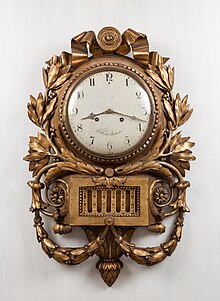A cartel clock is a cartouche shaped clock designed to hang directly on a wall, very commonly executed in fire-gilt bronze (a.k.a. ormolu). The form is a more unified development from a wall-mounted bracket clock standing upon its separate, complementary bracket characteristic of the Régence (1715–23), which continued to be stylish in Paris through the 1740s.[1] In Paris, where the ébéniste's wooden contribution to the case and wall bracket, conceived as complements in design, was by degrees overshadowed by gilt-bronze mounts. wholly gilt-bronze bracket clock cases became most common by ca 1730. The cartel clock, incorporating clock case and bracket in a single unified organic sculptural conception, was a Rococo invention initiated in Paris. Highly ornate Rococo examples exist, with flowing, asymmetrical and curvilinear designs, the most notable being a series of unified cartel clocks in half a dozen related models, dateable to the 1730s and 40s and attributed (some of them signed) to Charles Cressent.[2]


The style that originated in Paris was used there from ca 1730 through the reign of Louis XV. With the return of classicism under Louis XVI, however, cartel clocks fell from favour in Paris, where the domestic clock moved to the mantel.[3] In provincial French cities, and elsewhere on the Continent, cartel clocks were made in the neoclassical style (illustration, right) The style was adapted in Austria, Sweden and Switzerland, with the style used for clocks executed in wood and decorated with gold leaf.[4][5] Such cartel clocks were made into the 19th century.[6] With the "Second Rococo" beginning ca 1830, mid-18th century models were revived or imitated.
References
edit- ^ A bracket clock with its complementary bracket, by Gilles Lainé, both veneered in green-stained horn, with gilt-bronze mounts, in Winthrop K. Edey;s collection, can be dated 1745-49 from its crowned c stamps in the mounts (Edey 1967, fig. 24); two similar bracket clocks that have retained their matching brackets are illustrated here (Musée du Temps, Besançon).
- ^ Theodore Dell, ""The Gilt-Bronze Cartel Clocks of Charles Cressent," Burlington Magazine (April 1967), pp. 210-217
- ^ Winthrop Edey, French Clocks 1967:63.
- ^ Viktor Pröstler: Callweys Handbuch der Uhrentypen. Von der Armbanduhr zum Zappler. Callwey München 1994, ISBN 3-7667-1098-2; p. 118
- ^ Fritz von Osterhausen: Callweys Uhrenlexikon. München 1999, ISBN 3-7667-1353-1; p.50
- ^ Ernst von Bassermann-Jordan: Uhren; Ein Handbuch für Sammler und Liebhaber. Richard Carl Schmidt & Co. Berlin 1920; p.46